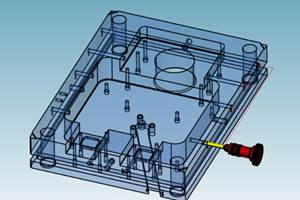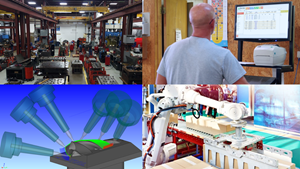Industry 4.0: EMO Update
This is not the first time a technical breakthrough was supposed to revolutionize the world of factories: we’re talking about computer-integrated manufacturing, or CIM for short. EMO HANNOVER asked the scientist Prof. Dr. Thomas Bauernhansel, Director of the Institute for Industrial Manufacturing and Management (IFF) and the Fraunhofer Institute for Manufacturing Engineering and Automation (IPA) in Stuttgart, about Industry 4.0. Following is a Q&A with Dr. Bauernhansel.
This is not the first time a technical breakthrough was supposed to revolutionize the world of factories: we’re talking about computer-integrated manufacturing, or CIM for short. EMO HANNOVER asked the scientist Prof. Dr. Thomas Bauernhansel, Director of the Institute for Industrial Manufacturing and Management (IFF) and the Fraunhofer Institute for Manufacturing Engineering and Automation (IPA) in Stuttgart, about Industry 4.0. Following is a Q&A with Dr. Bauernhansel.
When did you first hear of Industry 4.0, and what did you think of it?
“It was in 2011, at a meeting of the Fraunhofer Production Matrix. We all started to Google terms like cyber-physical systems, and tried to make sense of what could be meant by Industry 4.0. None of the production luminaries at this meeting had more than the vaguest idea. So the term was not coined by production experts but comes from the fields of IT and artificial intelligence. Nonetheless, production technology experts had been working on it for a very long time,” said Bauernhansel.
Humans take charge of value creation
What’s the difference from CIM?
“CIM was based on the assumption that we won’t be having people in the factory any more. The concept with CIM is that everything is highly integrated, and centrally controlled from a master computer. Here, humans now had merely an integrative function as planners and “commanders”. Industry 4.0 adopts an entirely fresh approach, focusing on communication, not integration. This means we have decentralized autonomous systems that communicate with each other, irrespective of the particular system and manufacturers involved. We say: the human being continues to play a central role in the factory, but a different one. He takes charge of the value creation process. And we are opting for data management in real-time. This means there’s no time-lagged data image in some central database. What happens is that the data are acquired in real-time at the places where they are currently being generated. In the context of control system technology, we’re talking about milliseconds here. In the context of planning and control, perhaps minutes or hours will suffice,” said Bauernhansel.
Industry 4.0 stands and falls with cyber-physical systems (CPSs). But there are experts who say they are often too expensive, not reliable enough and frequently overdimensioned. What’s your answer to one of these critics, who in fact comes from your own institute?
“My respected colleague Alexander Verl has rightly remarked that ultimately we have to focus on the cost-efficiency of these systems. This critical approach is important, so as in particular to rein in those among the vendors concerned, meaning software firms or also machinery manufacturers, who are scenting business opportunities for themselves here. Ultimately, the system as a whole has to offer an advantage to the customer who is buying a product. At the moment, Industry 4.0 is being driven very largely by factory equipment producers and less by the customers. So there’s not a market crying out for it, but there is a technology that’s looking for an application. So what my colleague Alexander Verl is saying is not in contradiction to my own stance, because in the final analysis the thing has to be commercially viable,” said Bauernhansel.
Data security is a problem
Might it also be that many companies fear going into Industry 4.0 because they’re worried their data might be stolen from the cloud? What’s the story behind the “Virtual Fort Knox”, in which, according to the institute, “jointly used sensitive data are as safe as the USA’s gold reserves in the legendary stronghold of Fort Knox”?
“There’s not going to be absolute data security in any system. It would be misleading to say security is going to be a huge problem, because security is already a huge problem now. Just as today we take the issue of security with the utmost seriousness, we shall take an equally serious approach when it comes to the issue of the cloud and concurrent users. And that’s precisely why we at the Fraunhofer IPA have launched the flagship project Virtual Fort Knox, in which we have taken a long hard look at everything: encoding and physical, communicative and organizational security: who is permitted to do what? Who has access and where?” said Bauernhansel.
What would you recommend in general? Should a cloud be located on the internet or rather in a firm’s own intranet?
“Each company has to find its own compromise, and then decide: what data will I not be putting on the net, and what data will I be putting on my own net? What data will be located in the private cloud and what knowledge for the customers and vendors on the public cloud?” said Bauernhansel.
Let me return for a moment to CIM, which only began to be more widely adopted after standardization. An expert from the automation sector has told me that standards for Industry 4.0 are a real turbo-boost for many activities, but the road to achieving a standard is very long and rocky. What’s your view on this?
“We’re not all that far away from standards: from a technical viewpoint, the problem of standardization has already been very largely solved in some fields. The actual problem is more the aspirations of firms who want to set these standards. Here we have to cultivate a community spirit. Even the major protagonists in this issue have to rethink their approach and say: yes, perhaps it makes sense that we have standardization and openness here, assuring everyone of access to the internet of things and services. After all, it’s no use to anyone if at the end of the day we have several different internets of things dominated by large companies. Only with a standardized system will new business models evolve, able to develop their full benefits for the end-user as well,” said Bauernhansel.
The German Research Union, in its “Implementation Recommendations for the Industry 4.0 Future Project”, proposes taking as a model the service-oriented architectures (SOAs), which support interlinked, re-usable applications. What’s your opinion of this proposal?
“I’m very much in favor of it. Service-oriented architecture has been discussed since the early 1990s. It’s not such a huge innovation on the IT side; it’s been around for a very long time. Really, it only goes to show how sluggishly the “oh-so-innovative” software industry adopts new ideas of this kind,” said Bauernhansel.
A glance into the future: what might a vision of Industry 4.0 look like?
“We decouple affluence and growth from resource consumption, and provide large amounts of the requisite technology through the Industry 4.0 initiative. The networking, the decentralization and the communication capabilities will lead to high levels of efficiency,” said Bauernhansel.
Perhaps on the way there we need some new input: “Inspired by technology” is the watchword at the 4th VDMA Congress on “More Intelligent Production”, which is being held at the EMO Hannover for the first time this year. What inspirational insights are you expecting from this congress and from the world’s premier trade fair for the metalworking sector?
“Inspired and driven by innovative technologies, the resource-efficiency potential for all production factors can be upgraded within the framework of Industry 4.0. Technology, not renunciation, has to be our motto. From the EMO Hannover and the congress, I am expecting approaches in this direction for holistically conceived, sustainable production operations of the future,” said Bauernhansel.
The interview was conducted by Nikolaus Fecht, a specialist journalist from Gelsenkirchen.
About EMO Hannover 2013
From September 16 to 21, 2013, international manufacturers of production technology will be spotlighting “Intelligence in Production” at the EMO Hannover 2013. The world’s premier trade fair for the metalworking industry will be showcasing the entire bandwidth of today’s most sophisticated metalworking technology, which is the heart of every industrial production process. The fair will be presenting the latest machines, plus efficient technical solutions, product-supportive services, sustainability in the production process, and much, much more. The principal focus of the EMO Hannover is on metal-cutting and forming machine tools, production systems, high-precision tools, automated material flows, computer technology, industrial electronics and accessories. The trade visitors to the EMO come from all major sectors of industry, such as machinery and plant manufacturers, the automotive industry and its component suppliers, the aerospace sector, precision mechanics and optics, shipbuilding, medical technology, tool and die manufacture, steel and lightweight construction. The EMO Hannover is the world’s most important international meeting point for production technology specialists from all over the planet. In 2011, the fair attracted more than 2,000 exhibitors, and around 140,000 trade visitors from more than 100 different countries. EMO is a registered trademark of the European Committee for Cooperation of the Machine Tool Industry CECIMO.
Related Content
Developments in High-Speed Machining Technology
There have been many exciting developments in high-speed machining relative to machining centers and controls, tooling and CAD/CAM systems.
Read MoreCAM Automation Increases Mold Production, Quality
Mold builder switches CAM software package after 20 years to take advantage of innovative programming strategies that reduce mold machining programming and processing times.
Read MoreDynamic Tool Corporation – Creating the Team to Move Moldmaking Into the Future
For 40+ years, Dynamic Tool Corp. has offered precision tooling, emphasizing education, mentoring and innovation. The company is committed to excellence, integrity, safety and customer service, as well as inspiring growth and quality in manufacturing.
Read MoreTool Paths, ERP & Improving Efficiency in Your Toolroom: What Did You Miss in February?
We covered a variety of topics in February. From tool paths to ERP and PTXPO coverage, we hope you didn’t miss anything but here is your cheat sheet if you did.
Read MoreRead Next
How to Use Continuing Education to Remain Competitive in Moldmaking
Continued training helps moldmakers make tooling decisions and properly use the latest cutting tool to efficiently machine high-quality molds.
Read MoreHow to Use Strategic Planning Tools, Data to Manage the Human Side of Business
Q&A with Marion Wells, MMT EAB member and founder of Human Asset Management.
Read MoreAre You a Moldmaker Considering 3D Printing? Consider the 3D Printing Workshop at NPE2024
Presentations will cover 3D printing for mold tooling, material innovation, product development, bridge production and full-scale, high-volume additive manufacturing.
Read More










.jpg;maxWidth=300;quality=90)









